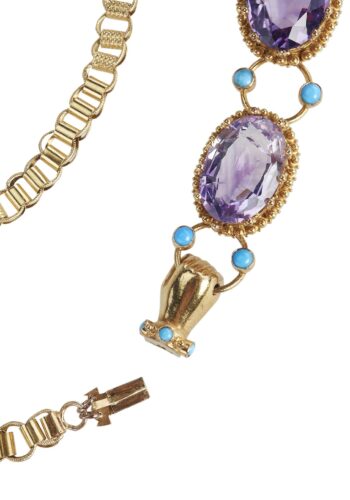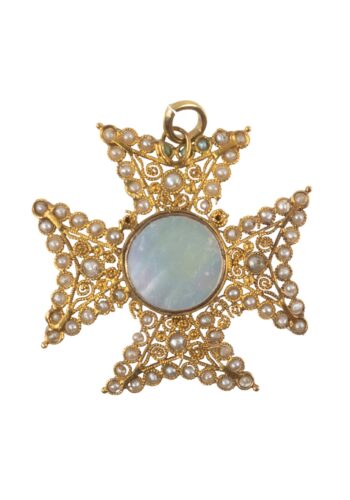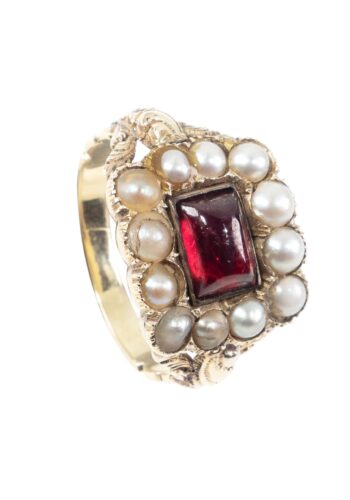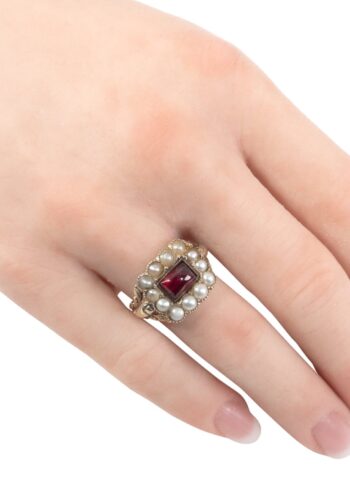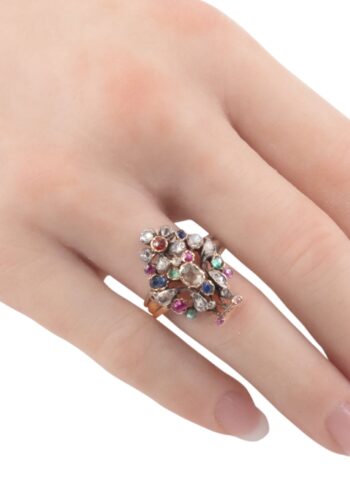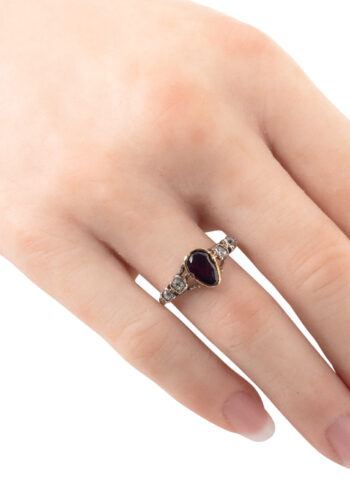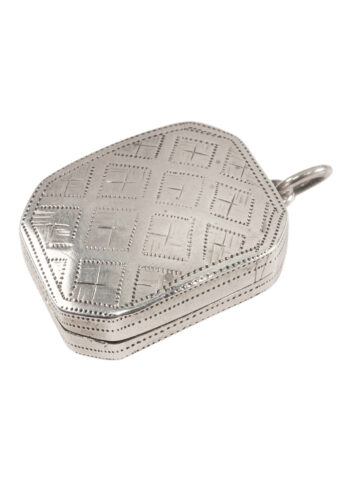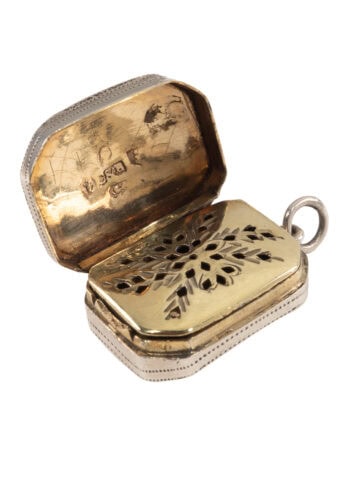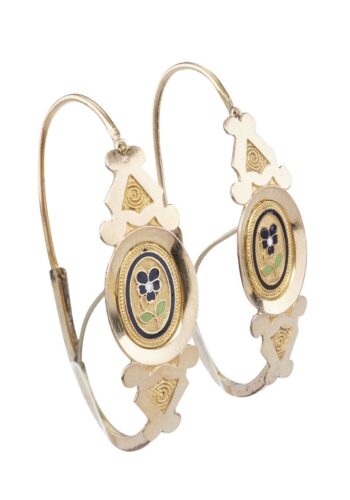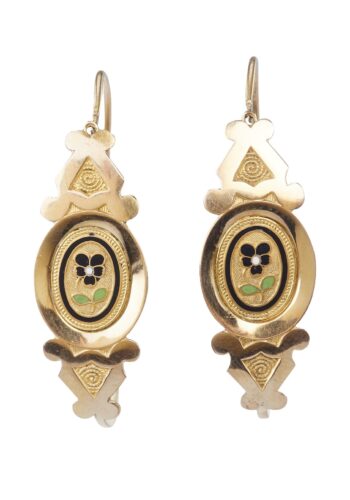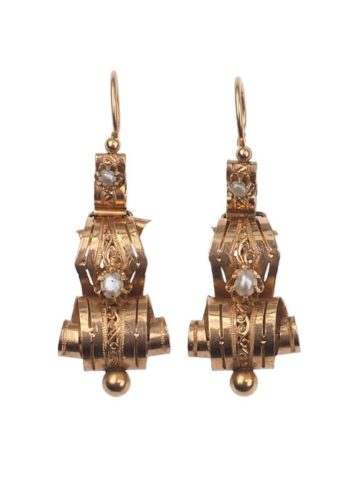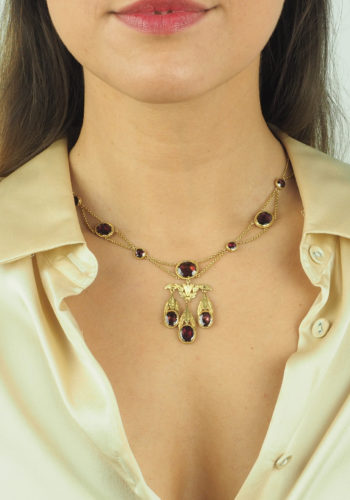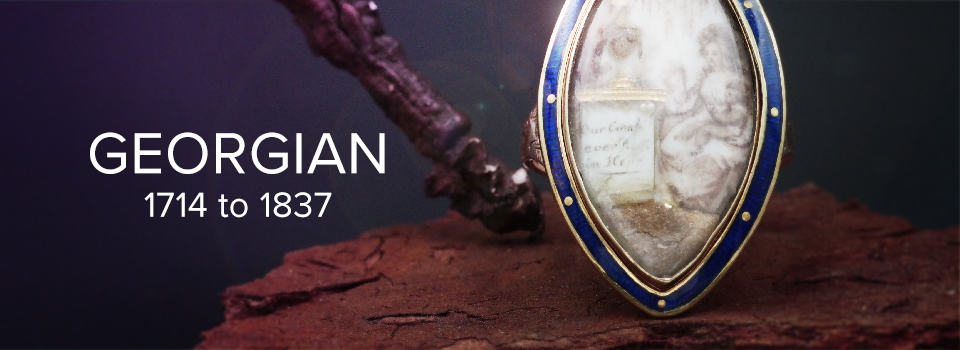
Georgian - 1714 to 1837
The oldest 'popular' epoch of the antique jewellery production spans the time of the regency of 4 Hanoverian kings, George I to George IV from 1714-1837. It is still divided into Palladian, early and late Georgian period. For the English rural population this was a time of strictly growing prosperity. The social and cultural consciousness clearly rose and the American colonies became so strong that they declared their independence in 1776. Looking back the foundation of the blossoming British Empire was created in the Georgian era.
Whether in Britain or in distant colonies, the growing political power and the wealth let arise everywhere architectural high-altitude flights and representations of the civilization and sophistication from British hand, or inspired by British hand. The industrial revolution changed the face of the country with lasting effect. Steam engines, for example, entered the industry and transportation achieved totally new qualities. Everybody could participate and become part of these epic changes. The spreading of reading and writing teachings promoted the rise of the book production. Printers published textbooks and stories and met the eager people therefore directly in the soul. Many newspapers found their natal hour and the arts blossomed in previously unattained levels. An urge to the ease, to colourful creations can be flawlessly reconstructed as well as mood influences like harmony, romanticism, poetry and beauty, which is unconditionally to be assigned to the Georgian epoch. Looking at Georgian jewellery, the obvious effect is accordingly: a special technology called ‚Repoussé‘ is the almost wasteful and fanciful treatment of a piece of jewellery by manual labour, which payed the same technical skill and attention to the back of a piece of the jeweller as the front.
The application of materials such as garnet, pearls, to amethysts as well as turquoises and not least roughly struck diamonds is typical for this epoch. Diamonds were often put on foils for strengthening higher glossy effects. The reflection resulted thereby created an illusion of a ‚dancing‘ diamond. The feverish search for better treatment methods and more exact grindings of diamonds was the consequence of the growing prosperity of the population and the associated need in sophisticated jewellery. The brilliant cut was the radiant result of these efforts! Alternatives to diamonds and brilliants in the Georgian were rock crystals, marcasites and pastels. Discover unique pieces from this time in our repertoire of the Georgian epoch. What else? From the beginning of the 19th century onwards shell cameos set in gold were the absolute jewellery trend! The finest miniatures and carvings in brooches and earrings got a popularity boost because of their use in the court jewels of Napoleon. The processing of steel to jewellery is also of Georgian origin and still today belongs to the most impressive manual techniques
Click to fold
Whether in Britain or in distant colonies, the growing political power and the wealth let arise everywhere architectural high-altitude flights and representations of the civilization and sophistication from British hand, or inspired by British hand. The industrial revolution changed the face of the country with lasting effect. Steam engines, for example, entered the industry and transportation achieved totally new qualities. Everybody could participate and become part of these epic changes. The spreading of reading and writing teachings promoted the rise of the book production. Printers published textbooks and stories and met the eager people therefore directly in the soul. Many newspapers found their natal hour and the arts blossomed in previously unattained levels. An urge to the ease, to colourful creations can be flawlessly reconstructed as well as mood influences like harmony, romanticism, poetry and beauty, which is unconditionally to be assigned to the Georgian epoch. Looking at Georgian jewellery, the obvious effect is accordingly: a special technology called ‚Repoussé‘ is the almost wasteful and fanciful treatment of a piece of jewellery by manual labour, which payed the same technical skill and attention to the back of a piece of the jeweller as the front.
The application of materials such as garnet, pearls, to amethysts as well as turquoises and not least roughly struck diamonds is typical for this epoch. Diamonds were often put on foils for strengthening higher glossy effects. The reflection resulted thereby created an illusion of a ‚dancing‘ diamond. The feverish search for better treatment methods and more exact grindings of diamonds was the consequence of the growing prosperity of the population and the associated need in sophisticated jewellery. The brilliant cut was the radiant result of these efforts! Alternatives to diamonds and brilliants in the Georgian were rock crystals, marcasites and pastels. Discover unique pieces from this time in our repertoire of the Georgian epoch. What else? From the beginning of the 19th century onwards shell cameos set in gold were the absolute jewellery trend! The finest miniatures and carvings in brooches and earrings got a popularity boost because of their use in the court jewels of Napoleon. The processing of steel to jewellery is also of Georgian origin and still today belongs to the most impressive manual techniques
Click to fold
-
Ca. 1820 – 18 ct. Gold necklace / Sautoir from Georgian England, with Amethysts & Turquoises
€ 5.900,00
Differential tax applies collectors items and antiques in accordance with German law §25a UStGFree Shipping -
Ca. 1810 – Citrine Earrings “Night+Day” French made
€ 4.900,00
Differential tax applies collectors items and antiques in accordance with German law §25a UStGFree Shipping -
Ca. 1820 – Maltese cross pendant
€ 1.590,00
Differential tax applies collectors items and antiques in accordance with German law §25a UStGFree Shipping -
Ca. 1820 – Georgian ring garnets and pearls
€ 1.690,00
Differential tax applies collectors items and antiques in accordance with German law §25a UStGFree Shipping -
Ca. 1790 – Georgian diamond ring
€ 3.500,00
Differential tax applies collectors items and antiques in accordance with German law §25a UStGFree Shipping -
Ca. 1740 – Giardinetti Ring
€ 6.900,00
Differential tax applies collectors items and antiques in accordance with German law §25a UStGFree Shipping -
Circa 1780 – Georgian ring with diamonds and garnet
€ 2.900,00
Differential tax applies collectors items and antiques in accordance with German law §25a UStGFree Shipping -
Dated 1806 – Vinaigrette hand-engraved, Birmingham
€ 390,00
Differential tax applies collectors items and antiques in accordance with German law §25a UStGFree Shipping -
Ca. 1820 – “Poissardes” French Earrings with Enamel decorations
€ 1.690,00
Differential tax applies collectors items and antiques in accordance with German law §25a UStGFree Shipping -
Dated 1753 – French Diamond Ring of Roségold & Silver
€ 3.500,00
Differential tax applies collectors items and antiques in accordance with German law §25a UStGFree Shipping -
Ca. 1830 – Memorial Gold Brooch with Enamel
€ 390,00
Differential tax applies collectors items and antiques in accordance with German law §25a UStGFree Shipping -
Ca. 1820 – French Rose Gold Earrings with Pearls
€ 1.790,00
Differential tax applies collectors items and antiques in accordance with German law §25a UStGFree Shipping -
Ca. 1830 – Cut Steel & Mother-of-pearl Bracelet
€ 1.290,00
Differential tax applies collectors items and antiques in accordance with German law §25a UStGFree Shipping -
Ca. 1830 – Cut Steel Bracelet, Georgian
€ 1.190,00
Differential tax applies collectors items and antiques in accordance with German law §25a UStGFree Shipping -
Ca. 1830 – Shell cameo Brooch with 18 ct. Gold frame, including original Box
€ 1.590,00
Differential tax applies collectors items and antiques in accordance with German law §25a UStGFree Shipping -
Ca. 1820 – Tiara / Glass, Strass & Pinchbeck
€ 1.890,00
Differential tax applies collectors items and antiques in accordance with German law §25a UStGFree Shipping -
Ca. 1800 – Georgian English Garnet earrings
€ 2.500,00
Differential tax applies collectors items and antiques in accordance with German law §25a UStGFree Shipping -
Ca. 1830 – Gold-plated Silver Earrings Georgian England
€ 790,00
Differential tax applies collectors items and antiques in accordance with German law §25a UStGFree Shipping -
Ca. 1830 – Coral Earrings “Night & Day”, English
€ 1.690,00
Differential tax applies collectors items and antiques in accordance with German law §25a UStGFree Shipping -
Ca. 1830 – Cut Steel Earrings from Georgian
€ 1.290,00
Differential tax applies collectors items and antiques in accordance with German law §25a UStGFree Shipping -
Ca. 1800 – 18 Carat Gold “Collier Esclavage”, French
€ 4.900,00
Differential tax applies collectors items and antiques in accordance with German law §25a UStGFree Shipping -
Ca. 1800 – Georgian-Ring with Diamonds & Enamel work
€ 12.400,00
Differential tax applies collectors items and antiques in accordance with German law §25a UStGFree Shipping -
Ca. 1830 – 18 ct. Gold & Silver Brooch with Diamonds, from Georgian England
€ 4.900,00
Differential tax applies collectors items and antiques in accordance with German law §25a UStGFree Shipping -
Ca. 1810 – French 18 Carat Gold Necklace, with closed setted Garnets
€ 5.900,00
Differential tax applies collectors items and antiques in accordance with German law §25a UStGFree Shipping





